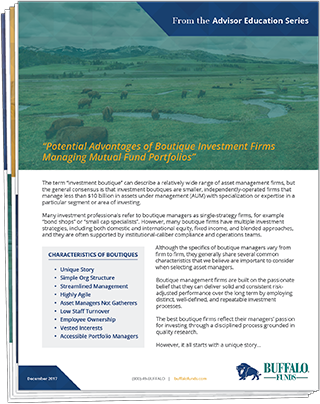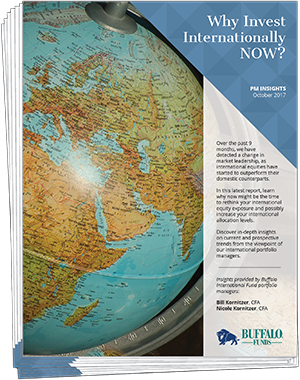The Morningstar Rating™ for funds, or "star rating", is calculated for managed products (including mutual funds, variable annuity and variable life subaccounts, exchange-traded funds, closed-end funds, and separate accounts) with at least a three-year history. Exchange-traded funds and open-ended mutual funds are considered a single population for comparative purposes. It is calculated based on a Morningstar Risk-Adjusted Return measure that accounts for variation in a managed product's monthly excess performance, placing more emphasis on downward variations and rewarding consistent performance. The top 10% of products in each product category receive 5 stars, the next 22.5% receive 4 stars, the next 35% receive 3 stars, the next 22.5% receive 2 stars, and the bottom 10% receive 1 star. The Overall Morningstar Rating™ for a managed product is derived from a weighted average of the performance figures associated with its three-, five-, and 10-year (if applicable) Morningstar Rating™ metrics. The weights are: 100% three-year rating for 36-59 months of total returns, 60% five-year rating/40% three-year rating for 60-119 months of total returns, and 50% 10-year rating/30% five-year rating/20% three-year rating for 120 or more months of total returns. While the 10-year overall star rating formula seems to give the most weight to the 10-year period, the most recent three-year period actually has the greatest impact because it is included in all three rating periods.
The Buffalo International Fund received 4 stars among 325 for the 3-year, 4 stars among 280 for the 5-year, and 5 stars among 192 Foreign Large Growth funds for the 10-year period ending 9/30/17.
©2017 Morningstar, Inc. All Rights Reserved. The information contained herein: (1) is proprietary to Morningstar; (2) may not be copied or distributed; and (3) is not warranted to be accurate, complete or timely. Neither Morningstar nor its content providers are responsible for any damages or losses arising from any use of this information. Past performance is no guarantee of future results.
Click here for current ratings of the Buffalo Funds.
The Overall Morningstar Rating™ for a managed product is derived from a weighted average of the performance figures associated with its three-, five-, and 10-year (if applicable) Morningstar Rating™ metrics.
While the U.S. News Mutual Fund Score combines all five equally weighted category scores to achieve its weighting, Lipper intends its measures to be used as individual assessments of a fund's ability to meet specific goals, rather than as a cumulative measure of fund quality. Lipper rankings are comprised of five unique measures (Total Return, Consistent Return, Preservation, Expense, and Tax Efficiency), each with a 1-to-5 score, ranking each fund against its peers. The highest 20% of funds in each peer group are named Lipper Leaders, the next 20% receive a rating of 4, the middle 20% are rated 3, the next 20% are rated 2, and the lowest 20% are rated 1. The overall calculation is based on an equal-weighted average of percentile ranks for each measure over three-, five-, and ten-year periods (if applicable). Lipper Ratings for Total Return reflect funds’ historical total return performance relative to peers. Lipper Ratings for Consistent Return reflect funds’ historical risk-adjusted returns, relative to peers. Lipper Ratings for Preservation reflect funds’ historical loss avoidance relative to other funds within the same asset class. Lipper Ratings for Tax Efficiency reflect funds’ historical success in postponing taxable distributions relative to peers. Lipper Ratings for Expense reflect funds’ expense minimization relative to peers with similar load structures.
The Zacks Mutual Fund Rank ranks funds on a scale from 1 to 5, with 1 being a Strong Buy and 5 being a Strong Sell. Each quarter, Zacks updates their Mutual Fund Rank by evaluating the average Zacks Rank for the stocks owned by the fund and blending this with other criteria their studies show is beneficial in finding funds that will outperform in the future. In general, the higher the average Zacks Rank for the stocks in the fund, then the higher the Zacks Mutual Fund Rank.
TheStreet.com Ratings Investment Ratings for Funds condense the available fund performance and risk data into a single composite opinion of each fund's risk-adjusted performance. “A (Buy) Excellent” rating means the fund has an excellent track record of maximizing performance while minimizing risk, thus delivering the best possible combination of total return on investment and reduced volatility. “B (Buy) Good” rating means the fund has a good track record of balancing performance with risk. “C (Hold) Fair” rating ratings means the fund has a track record which is about average. “D (Sell) Weak” rating means the fund has underperformed the universe of other funds given the level of risk in its underlying investments, resulting in a weak risk-adjusted performance. “E (Sell) Very Weak” rating means the fund has significantly underperformed most other funds given the level of risk in its underlying investments, resulting in a very weak risk-adjusted performance. The plus sign (+) is an indication that the fund is in the top third of its letter grade. The minus sign (-) is an indication that the fund is in the bottom third of its letter grade. “U Unrated” rating means the fund does not have sufficient history to make a reliable assessment of its risk-adjusted performance.
The CFRA Rankings range from five-star (highest) to one-star (lowest) and follow a normalized distribution curve, based upon the fund’s rank in its Category. Top 10% receive five stars, next 20% receive four stars, middle 40% receive three stars, next 20% receive two stars, and the bottom 10% receive one star. Rankings are refreshed on a weekly basis to incorporate the latest inputs from the holdings-based analysis and the latest relative performance review.
Performance data quoted represents past performance; past performance does not guarantee future results. The investment return and principal value of an investment will fluctuate so that an investor’s shares, when redeemed may be worth more or less than their original value. Current performance may be lower or higher than the performance quoted. Performance data current to the most recent month-end may be obtained here. Performance data current to the most recent quarter-end may be obtained here.
Opinions expressed are those of the author or Funds and are subject to change, are not intended to be a forecast of future events, a guarantee of future results, nor investment advice.
References to other mutual funds should not to be considered an offer to buy or sell these securities.








